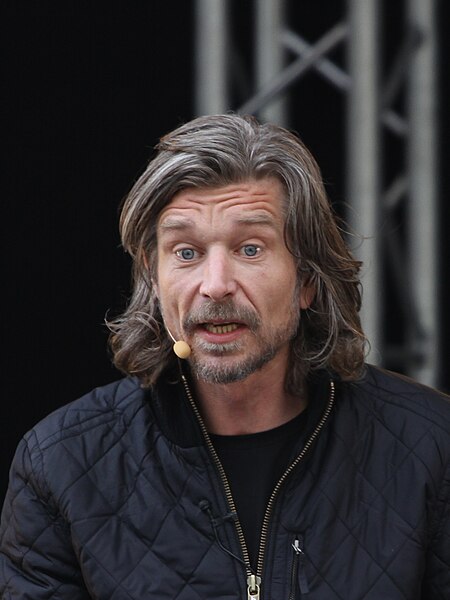The Raw Intimate Experience of Reading the New (unromantic) Romantics
Karl Ove Knausgård image by Kjetil Ree (CC BY-SA 3.0)
Karl Ove Knausgaard is coming to the IFOA in October. Be sure to check him out. He has turned fiction on its head by using real names in his fictional work. I talked more about this in my essay in the Globe this spring: Here is the old unedited draft I wrote for the Globe, warts and all:
Growing older, it’s not only the wrinkles I notice, but a new sensibility created by a generation of younger writers. If I felt paranoid, their sensibility could rock my boat. But I love new frontiers so for me, their writing is a reason to get excited.
One of the leaders of the new writing, a generation I call “the new (unromantic) romantics,” is Karl Ove Knausgaard, a Norwegian novelist who has created an explicit and powerful autobiographical fiction that has been standing the literary world on its ear. This spring, the third volume of Knausgaard’s six novel series titled My Struggle is out in English. It follows the English translations of his first two novels. Three more volumes in English are coming soon.
I’ve read My Struggle: Book One and volume two titled A Man in Love, so I came prepared to Boyhood Island. But before I talk about Knausgaard’s fearless work let me explain why I see him as part of the new writing. While literary prizes are lost or won, and creative writing schools teach graduates how to shape story arcs, this brash new fiction has been finding a younger, less traditional audience for its very non-traditional approach.
Influenced by the confessional nature of the Internet, with its disregard for literary forms, the younger generation of fiction writers includes Sheila Heti, whose brainy, original novel How Should a Person Be? is quickly becoming a classic; Ben Lerner, author of Leaving the Atocha Station, a virtuoso tale of self-exposure; and Kate Zambreno, who wrote Heroines, a daring personal account about the condescending way modernist fictional heroines were treated.
Countless others under forty are part of this gritty new sensibility, novelists like Tamara Faith Berger, author of the vivid, transgressive Maidenhead, and Marie Calloway who wrote about her sexual exploits in the unclassifiable, what purpose did I serve in your life.
Most fiction offers us a story or plot. But the audacious fictional accounts of the new romantics often have little time for narrative masks or literary frames. They aren’t interested in post-modernism either and its fascination with how stories are told. Disclosure is the spirit of our age, and their work seems designed to bring the reader “close to a self,” as Knausgaard puts it.
For instance, when Sheila Heti started writing How Should A Person Be? she purposefully did everything a writer of realistic fiction is NOT supposed to do. She disregarded the modernist notion that the novelist should be invisible behind his or her work and she ignored the dictum about coming up with the brilliant, telling detail that conveys the world of a story.
The authorial signature of this generation vis-a-vis most modern novelists is like comparing a naked story teller to one in an Edwardian ball gown. Or maybe it’s more like the difference between a very intelligent reality TV contestant and an English professor schooled in Victorian literature.
Why do I call them romantics? This new generation of fiction writers makes the self their subject and describing the self and its emotions was a preoccupation of the early Romantics.
Of course, writers like Henry Miller and Marcel Proust have made themselves the subject of their fiction before, but their work is washed through with romanticism and its view of the writer as an Olympian explorer of the human spirit. No such romantic notion of the writer shows up in the writing of the new generation who report on the deepest, shallowest, creepiest and most unworthy feelings and thoughts that can go on inside an individual.
Ultimately, there’s nothing dignified or heroic in their stance, although the authoritative “I” who writes the story always gets the last word, and there’s a tinge of Olympian power in that.
Knausgaard, at 45, goes further than most of them. His fiction is controversial because it says extremely revealing things about real people in his life without bothering to disguise their identities.
In interviews, Knausgaard says that the naming of real people is an ethical issue but he believes that to create literature of lasting value, a writer must carve a freedom outside the rules of society. That means putting honesty before consideration. These days he tends to beat himself up over the pain his fiction caused his family. But when he was writing My Struggle he put his art first. He had felt bored and overwhelmed by the millions of paperbacks, hardbacks, DVDs and TV series whose stories were all about made-up people in a made-up world. He preferred genres like diaries and essays that focused on the voice of the writer’s personality.
So in all three English volumes he immerses the reader in his Norwegian time and place without worrying much about narrative structure. Knausgaard excels instead at describing sensory details, whether he’s writing about the shelves of sweets he saw in stores as a boy, or his deep shuddering hatred of his tyrannical father. It’s the depth of his far ranging feelings and philosophical reflections that make his autobiographical work read like fiction. (I used to teach a course in the memoir at York University and most contemporary memoirs describe a less complicated journey through one particular kind of experience.)
Critics sometimes compare Knausgaard to Marcel Proust, and the two are certainly alike in their flowing descriptions about the minutiae of daily life. One critic said it took Proust seven pages to describe a man turning in his bed. You could say the same sort of the thing about Knausgaard. But the similarity stops there.
Proust was writing elegantly about retrieving lost time and he sometimes disguised gay relationships as heterosexual. Knausgaard, on the other hand, is telling shamelessly personal truths with an excoriating honesty that feels masochistic. For instance, he incorporates a description of his bowel movements because he sees “shitting” as worthy of attention too.
In the first two widely praised volumes of My Struggle, he deals with his difficulties as a boy, the son of an English teacher and a nurse, and later, his frustrations with trying to write while he helps his wife raise their children. In volume two, although he accepted child-raising as the duty of a progressive husband, he walked around the streets of Stockholm “with a furious nineteenth-century man inside me.”
In volume one, Knausgaard deals with his father’s death from alcoholism, and describes the experience of cleaning up his father’s childhood home, where furniture has been burnt and excrement has been smeared on the furniture and the walls.
In this third volume, Boyhood Island, he exhibits the same hypnotic descriptive powers displayed in the first two volumes. And his father and his pernicious influence on Knausgaard emerges as the central theme. He takes almost four hundred pages to tell us how the man terrified him, (not by beatings or starving a child), but through a continuous vicious deflating of a child’s natural boisterous spirit.
In one of the childhood scenes, Knausgaard describes himself looking out the window and watching a cat hunting a mouse. What could be more clichéd than a cat chasing a mouse? Yet he brings the mouse’s fear and the cat’s playful cruelty to life on the page. As I read on, it was obvious the cat and the mouse were a metaphor for Knausgaard’s relationship with his father.
Here he is describing his father in volume three: “I was so frightened of him that even with the greatest effort of will I am unable to recreate the fear …His footsteps on the stairs—was he coming to see me? The wild glare in his eyes. The tightness around his mouth… And then his voice: Sitting here now, hearing it in my inner ear, I almost start crying.”
In adolescence, other children called Knausgaard “a Jessie,” high school slang for an androgynous person. Knausgaard knew it wasn’t true; he was a teenage boy who loved boyish things like sports and pop music but he still suffered over not fitting in.
Knausgaard’s father, who was modern enough to share household chores with his wife, had a Victorian remedy for his child’s problems; he would lash out when the boy expressed his feelings. As a result, Knausgaard’s childhood struggle to be himself may have set up a life pattern that’s repeated in his fiction. First, there’s self-expression, followed by anger and retribution. (Some of Knausgaard’s family tried to sue him when the first volume was published, then dropped their case.)
Luckily, Knausgaard’s mother was a kinder, gentler person. She encouraged Knausgaard in his love of books although, mysteriously, she didn’t protect him from his father’s verbal abuse or cruelty. When the pair separate, the mother seems weirdly detached. Either she couldn’t share her emotional grief over a failed relationship, or like many women of her generation, she was relieved to rid herself of a difficult husband.
So Boyhood Island is another triumph for Knausgaard.
However, Boyhood Island didn’t always hold my attention and I longed for more of his philosophical reflections on adult life. Maybe agency is necessary to sustain a lengthy narrative, and agency is what children lack. Knausgaard himself points out that the landscape in childhood is different. In childhood, he writes “every rock, every tree, has a meaning and because everything is seen for the first time and because it is seen so many times it is anchored in the depths of your consciousness not as something vague or approximate the way a landscape outside a house appears to an adult … but as something with immense precision and detail.”
In other words, childhood is a land of sharply felt sensory impressions, and he’s described it masterfully, shaking out his younger self like a pillow until the stuffing, feathers and all, bursts out and floats away on the wind.
(Susan Swan’s latest novel The Western Light will be available this June in paperback.)


